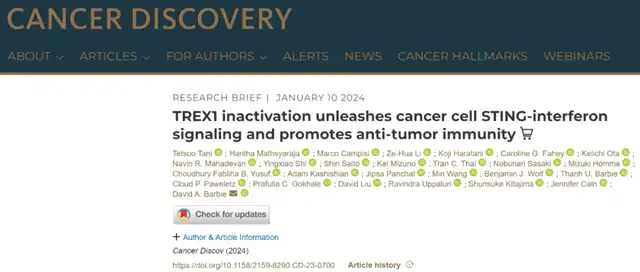Harvard Study: Targeting TREX1 for Cancer Immunotherapy Breakthrough
- Normal Liver Cells Found to Promote Cancer Metastasis to the Liver
- Nearly 80% Complete Remission: Breakthrough in ADC Anti-Tumor Treatment
- Vaccination Against Common Diseases May Prevent Dementia!
- New Alzheimer’s Disease (AD) Diagnosis and Staging Criteria
- Breakthrough in Alzheimer’s Disease: New Nasal Spray Halts Cognitive Decline by Targeting Toxic Protein
- Can the Tap Water at the Paris Olympics be Drunk Directly?
Harvard Study: Targeting TREX1 for Cancer Immunotherapy Breakthrough
- Should China be held legally responsible for the US’s $18 trillion COVID losses?
- CT Radiation Exposure Linked to Blood Cancer in Children and Adolescents
- FDA has mandated a top-level black box warning for all marketed CAR-T therapies
- Can people with high blood pressure eat peanuts?
- What is the difference between dopamine and dobutamine?
- How long can the patient live after heart stent surgery?
Harvard Study: Targeting TREX1 for Cancer Immunotherapy Breakthrough
Harvard Team Discovers Activation of Innate Immune Pathway in Cancer Immunotherapy by Inhibiting TREX1 Enzyme.
In a recent study published in the Cancer Discovery journal, researchers from Harvard Dana-Farber Cancer Institute and Gilead Sciences have uncovered a novel approach to enhance cancer immunotherapy by inhibiting the activity of the nucleic acid exonuclease TREX1 in cancer cells.

To better activate the anti-tumor immune response and assist immune checkpoint inhibitors (ICIs) in the forefront of the battle against cancer, the scientific community has been exploring unconventional avenues for inspiration. Building on previous research that focused on inhibiting the RNA helicase DHX9 to simulate viral infection, the current study targets TREX1, an exonuclease adaptive regulator whose inhibition catalyzes a decrease in the degradation of cytoplasmic DNA, effectively activating the STING-IFN pathway and facilitating anti-tumor immune responses.
This approach differs from the previous inhibition of DHX9, which simulated viral infection. The study’s focus on TREX1 pertains to a group of diseases known as interferonopathies, where continuous activation of the STING-IFN pathway is associated with abnormal autoimmune responses and inflammation. The loss of function mutations in TREX1 has been confirmed to be pathogenic in diseases like Aicardi-Goutières syndrome.
The study suggests that by inhibiting TREX1, which normally suppresses the STING pathway’s perception of abnormal cytoplasmic DNA accumulation, researchers can activate the STING-IFN pathway and promote anti-tumor immune responses.
Previous research has shown that the well-known tumor suppressor gene p53 also utilizes a similar mechanism by promoting TREX1 degradation to activate the STING pathway for cancer inhibition. To validate and further understand TREX1’s role in cancer immune responses, the researchers conducted experiments on non-small cell lung cancer (NSCLC) cell lines. The results indicated that inhibiting TREX1 led to an upregulation of its expression, acting as a countermeasure by cancer cells against STING pathway activation.
Functional loss mutations, such as TREX1-D18N/D200N, failed to inhibit the changes induced by STING pathway activation, highlighting the importance of retaining catalytic functionality in TREX1 to suppress the STING-IFN pathway. Eliminating TREX1 in cancer cells effectively amplified STING-IFN signals through both endocrine and paracrine mechanisms, recruiting CD8+ T cells and NK cells to the tumor site and enhancing the overall tumor immune response.
The researchers also evaluated the impact of TREX1 on immune responses in other types of cancer cell lines, including endometrial cancer and colorectal cancer, showing similar favorable changes. TREX1 inhibition in melanoma cells resistant to immune therapy demonstrated a clear role in reversing resistance and synergistically enhancing the effectiveness of PD-1 inhibitors.
In conclusion, TREX1 emerges as a promising target in the era of cancer immunotherapy, potentially becoming a widely applicable and immune response-activating anti-cancer target. Some investigational small molecule TREX1 inhibitors have already made appearances at international academic conferences. The next time their efficacy data astounds you, remember to control your expressions and recall the mechanisms elucidated by these researchers.
Harvard Study: Targeting TREX1 for Cancer Immunotherapy Breakthrough
References:
[1]Tani T, Mathsyaraja H, Campisi M, et al. TREX1 inactivation unleashes cancer cell STING-interferon signaling and promotes anti-tumor immunity[J]. Cancer Discovery, 2024.
[2]Kretschmer S, Lee-Kirsch M A. Type I interferon-mediated autoinflammation and autoimmunity[J]. Current Opinion in Immunology, 2017, 49: 96-102.
[3]Ghosh M, Saha S, Li J, et al. p53 engages the cGAS/STING cytosolic DNA sensing pathway for tumor suppression[J]. Molecular Cell, 2023, 83(2): 266-280. e6.
[4]Salojin C, Gardberg A, Vivat V, et al. 765 The first-in-class small molecule TREX1 inhibitor CPI-381 demonstrates type I IFN induction and sensitization of tumors to immune checkpoint blockade[J]. Journal for ImmunoTherapy of Cancer, 2021, 9(Suppl 2): A800.
[5]Francica B, Burdette D, Clark R, et al. Systemic small molecule TREX1 inhibitors to selectively activate STING in the TME of metastatic disease[J]. Cancer Research, 2022, 82(12 Suppl): 2075.
(source:internet, reference only)
Disclaimer of medicaltrend.org
Important Note: The information provided is for informational purposes only and should not be considered as medical advice.



